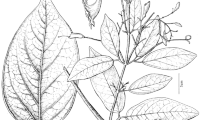Abstract
Two species of Leandra that occur in low montane and montane rain forests in the state of Espírito Santo, Eastern Brazil, are described and illustrated here. Leandra magnipetala can be recognized by the pedicellate flowers, costate hypanthia, and large, broadly lanceolate petals. Leandra triantha can be recognized by the apical, short-peduncled triads, diads or solitary flowers and by the granulose-glandulose, strigose and glandulose-strigose bracts, bracteoles, and hypanthia.
Resumo
Duas espécies de Leandra que ocorrem em Floresta Ombrófila Densa Submontana e Montana no estado do Espírito Santo são aqui descritas e ilustradas. Leandra magnipetala pode ser reconhecida pelas flores pediceladas, hipanto costado, e pelas pétalas grandes, largamente lanceoladas. Leandra triantha pode ser reconhecida pelas flores em tríades, díades ou isoladas, sempre apicais e sobre pedúnculos curtos, e pelas brácteas, bractéolas e hipanto com indumento granuloso-glanduloso, glanduloso e estrigoso.


Similar content being viewed by others
Literature Cited
Baumgratz, J. F. A. 1999. Duas espécies novas de Huberia DC (Melastomataceae) para o Brasil. Novon 50: 39–47.
Camargo, E. A. & R. Goldenberg. 2007. O gênero Leandra, seção Leandraria (Melastomataceae) no Paraná. Iheringia-série Botânica 62: 105–113.
Camargo, E. A. & R. Goldenberg. 2009. O gênero Leandra, seções Carassanae, Chaetodon, Niangae, Oxymeris e Secundiflorae (Melasomataceae) no Paraná. Rodriguésia 60: 595–631.
Cogniaux, A. 1886–1888. Melastomataceae. Miconieae. In: C. F. P. Martius, A. G. Eichler & I. Urban (eds.). Flora Brasiliensis 14 (4): 64–558.
Cogniaux, A.. 1891. Melastomataceae. In: A. De Candolle & C. De Candolle (eds.). Monographiae Phanerogamarum 7: 1–1256.
Goldenberg, R. 1999. A new species of Miconia Ruiz & Pavón (Melastomataceae) from Espírito Santo, Brazil. Novon 9: 514–516.
——— & M. Reginato. 2007. Three new species of Melastomataceae from the southeastern Atlantic Forest of Brazil. Brittonia 59: 334–342.
——— & M. Reginato. 2009. New species of Behuria, Miconia and Ossaea (Melastomataceae) from eastern Brazil. Journal of the Torrey Botanical Society 136: 293–301.
——— & R. A. Tavares. 2007. A new species of Dolichoura (Melastomataceae) and broadened circumscription of the genus. Brittonia 59: 226–232.
———, D. S. Penneys, F. Almeda, W. S. Judd & F. A. Michelangeli. 2008. Phylogeny of Miconia (Melastomataceae): patterns of stamen diversification in a megadiverse neotropical genus. International Journal of Plant Sciences 169: 963–979.
Guimarães, P. J. & R. Goldenberg. 2001. A new species of Tibouchina Aubl. (Melastomataceae) from Espirito Santo, Brazil. Kew Bulletin 56: 989–993.
IUCN. 2001. Red List categories and criteria. IUCN, Gland and Cambridge.
Judd, W. S. 1986. Taxonomic studies in the Miconieae (Melastomataceae). I. Variation in inflorescence position. Brittonia 38: 150–161.
——— & J. D. Skean, Jr. 1991. Taxonomic studies in the Miconieae (Melastomataceae) IV. Generic realignments among terminal-flowered taxa. Bulletin of the Florida Museum of Natural History, Biological Sciences 36 (2): 2584.
Martin, C. V. & F. A. Michelangeli. 2009. Comparative seed morphology of Leandra (Miconieae, Melastomataceae). Brittonia 61: 175–188.
———, D. P. Little, R. Goldenberg & F. A. Michelangeli. 2008. A phylogenetic evaluation of Leandra (Miconieae, Melastomataceae): a polyphyletic genus where the seeds tell the story, not the petals. Cladistics 23: 1–13.
Mendes, S. L. & M. P. Padovan. 2000. A Estação Biológica de Santa Lúcia, Santa Teresa, Espírito Santo. Boletim do Museu de Biologia Mello Leitão (Nova Série) 11/12: 7–34.
Michelangeli, F. A., D. S. Penneys, J. Giza, D. Soltis, M. H. Hils & J. D. Skean. 2004. A preliminary phylogeny of the tribe Miconieae (Melastomataceae) based on nrITS sequence data and its implication on inflorescence position. Taxon 53: 279–290.
Reginato, M., F. A. Michelangeli & R. Goldenberg. 2010. Phylogeny of Pleiochiton A. Gray (Melastomataceae, Miconieae): total evidence. Botanical Journal of the Linnean Society 162: 423–434.
Renner, S. S. 1993. Phylogeny and classification of the Melastomataceae and Memecylaceae. Nordic Journal of Botany 13: 519–540.
Simonelli, M. & C. N. Fraga. 2007. Espécies da Flora Ameaçadas de Extinção do Espírito Santo. IPEMA, Vitória.
Tavares, R. A., J. F. Baumgratz & R. Goldenberg. 2008. A new species of Behuria Cham. (Melastomataceae: Merianieae) from Brazil. Botanical Journal of the Linnean Society 158: 489–492.
Veloso, H. P., A. L. Rangel-Filho & J. C. A. Lima. 1991. Classificação da vegetação brasileira, adaptada a um sistema universal. IBGE, Rio de Janeiro.
Wurdack, J. J. 1962. Melastomataceae of Santa Catarina. Sellowia 14: 109–217.
Acknowledgments
Field work was partially funded by the “Fundação O Boticário de Proteção à Natureza” (Proc. 0756-20072), and by the United States National Science Foundation (DEB-0818399, coordinated by F. Michelangeli). This research was also funded by a grant to the first author by CNPq (Proc. 305269/2006-2). We thank William Rodrigues for the Latin diagnosis, M. Reginato and F. Almeda for the comments on the manuscript, L. Kollmann for sending the specimens of L. triantha, and also L. Kollmann, Rafaela Forzza, André Amorim, Claudio Fraga, Paulo Labiak, and André Fontana for the help in the field. Diana Carneiro prepared the line drawings.
Author information
Authors and Affiliations
Corresponding author
Rights and permissions
About this article
Cite this article
Camargo, E.A., Goldenberg, R. Two new species of Leandra from Espírito Santo, Brazil. Brittonia 63, 220–226 (2011). https://doi.org/10.1007/s12228-010-9154-0
Published:
Issue Date:
DOI: https://doi.org/10.1007/s12228-010-9154-0




